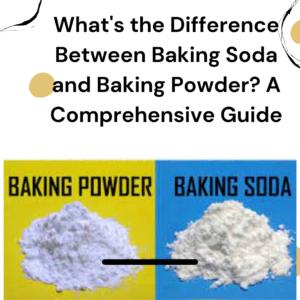
What’s the Difference Between Baking Soda and Baking Powder? A Comprehensive Guide
Introduction
Baking soda and baking powder are two of the most common leavening agents used in baking. Leavening agents are responsible for making baked goods rise.
But what is the difference between baking soda and baking powder? And which one should you use for your recipes?
In this blog post, we’ll discuss the chemical composition and best uses of baking soda and baking powder. We’ll also provide tips on how to troubleshoot common problems that can occur when using these leavening agents.
Chemical composition of baking soda and baking powder
Baking soda is a pure sodium bicarbonate, while baking powder is a mixture of sodium bicarbonate, cream of tartar, and cornstarch.
How baking soda works
Baking soda is a base, which means that it reacts with acids to produce carbon dioxide gas. This gas creates bubbles in the batter, which expand when heated and cause the baked good to rise.
How baking powder works
Baking powder is a double-acting leavening agent, which means that it reacts twice to produce carbon dioxide gas. The first reaction occurs when the baking powder is mixed with water. The second reaction occurs when the baking powder is heated.
Best uses for baking soda and baking powder
Baking soda is typically used in recipes that contain an acidic ingredient, such as buttermilk, yogurt, or lemon juice. The acidic ingredient reacts with the baking soda to produce carbon dioxide gas, which causes the baked good to rise.
Baking powder is typically used in recipes that do not contain an acidic ingredient. It is also used in recipes that require a more sustained rise, such as cakes and cookies.
Here is a table that summarizes the key differences between baking soda and baking powder:
| Characteristic | Baking Soda | Baking Powder |
| Chemical composition | Sodium bicarbonate | Sodium bicarbonate, cream of tartar, and cornstarch |
| How it works | Reacts with acids to produce carbon dioxide gas | Reacts twice to produce carbon dioxide gas: once when it is mixed with water and again when it is heated |
| Best uses | Recipes that contain an acidic ingredient | Recipes that do not contain an acidic ingredient or recipes that require a more sustained rise |
Troubleshooting common problems
Here are a few common problems that can occur when using baking soda and baking powder:
- Baked goods are flat: This can be caused by using too little leavening agent, not mixing the batter enough, or overbaking the baked goods.
- Baked goods have a bitter taste: This can be caused by using too much baking soda or by not baking the baked goods long enough.
- Baked goods have a metallic taste: This can be caused by using too much baking powder.
Additional resources for baking recipes
Here are a few additional resources for baking recipes:
- The Pioneer Woman: https://thepioneerwoman.com/
- Sally’s Baking Addiction: https://sallysbakingaddiction.com/
- Gimmie Some Oven: https://gimmesomeoven.com/
- Allrecipes: https://www.allrecipes.com/
- Food Network: https://www.foodnetwork.com/
What is your favorite baking recipe that uses baking soda or baking powder? Share it in the comments below!
Conclusion
Baking soda and baking powder are two essential ingredients for baking. By understanding the chemical composition and best uses of each leavening agent, you’ll be able to choose the right one for your recipes and bake delicious baked goods every time.
